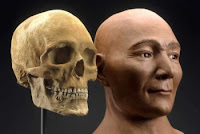This is an example of several different composite sketches done by a forensic artist. Creating composite drawings of criminals is merely one of the many duties of a Forensic Artist. Composite drawings of the crime scene, decompostional/postmortem sketches, detailed 3D facial reconstructions, and the use of age progression software are also included. All of which are based solely on descriptions given by victims and/or witnesses. A forensic artist, though it is not required, should obtain a BFA with traditional drawing skills; more specifically, portraiture and fine art skills as these will help render anatomic proportions. As the artist speaks closely with victims of crime, and sometimes even a confessed accomplice, it is beneficial to have some sort of background in psychology and/or counseling.
In the case of 3D facial reconstructions, the artist relies only on the details of the skull, or whatever remains of the victim to reconstruct and shape the face to identify the deceased. Orifices in the skull are measured and carefully calculated to produce accurate layering of the skin and placement of eyes, nose, lips, etc. This is an example of 3D facial reconstruction:
Age progression software, which has become increasingly useful today allows the artist to input an image of someone say, at the age of 5, and progress their age to that of a 10 or 12 year old (or older in some cases) to better identify those who have been missing for extended periods of time. Typically this software is used in cases such as kidnappings or runaways. This is an example of a young girl's photo, used in the age progression process:
I currently aspire to pursue a career in the challenging field of Forensic Art. Through my schooling at Highline Community College where I obtained my AA Degree in Art, and my current schooling at Northwest College of Art, I have realized that art is certainly what I wish to pursue. Since I can remember, I've always enjoyed volunteering, and applying my skills where they could help. Ultimately, I feel like forensic artistry provides the the most satisfactory combination of my life's ambitions: To serve and be a part of my community, or one in need....and to utilize my skill, and something that I love in the process.
Several people ask, what about computers? Aren't they taking over these days? In response to that question, yes. Regardless, traditional skill is useful no matter what, and will only heighten my accuracy even if I end up using only computers. In the process of gathering the skill set I will need most, I learn so many other things that I value and utilize. Though technology is rather advanced in the field, I feel that the traditional skill set will remain of high importance for many years to come, but work along side the computer aspects.
As I continue to study the career path, and produce composite sketches of my own, I will compile a body of my best work and post them here for feedback.
The best way to predict your future is to create it. -Peter Drucker



Whenever I read your writing I feel like I'm reading from an established, professional and educated standpoint; combine that with your knack of descriptive writing and it's amazing; whatever your final decision on your path is, I'm sure you'll be incredible.
ReplyDelete